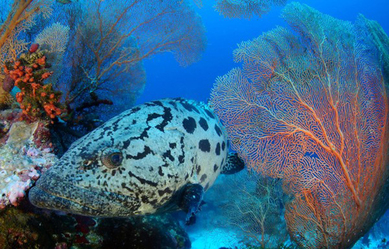|
Coral reefs are not only extremely diverse marine ecosystems, hosting many species, they are also eye candy for divers and snorkelers. Some major facts about corals, resuming a recent article by Nicole Helgason, PADI Dive Instructor at ScubaDiverLife. Coral reefs are not only extremely diverse marine ecosystems, hosting many species, they are also eye candy for divers and snorkelers.
Some major facts about corals, resuming a recent article by Nicole Helgason, PADI Dive Instructor at ScubaDiverLife. 1. Corals are colonial animals formed by many identical polyps. The individual polyps look like sea anemones, with similar body structure: mouth, stomach and tentacles. During the nights these tentacles are exposed and waiting for the meals to pass by. Some have longer tentacles too, to catch food, or sting other corals that encroach on their territory. 2. There are two general categories, hard corals, where polyps form hard skeletons and soft corals, where jelly-like or rigid, spiny structures hold together soft coral polyps. Another difference is that hard corals are built on a six-fold symmetry, while soft corals are built on an eight-fold symmetry. 3. Hard corals live in tropical, sunny waters, where light penetrates the ocean water to a depth of approximately 230 feet (70 m). Optimal water temperatures for corals are between 73 and 84 F (23 and 29 C), although some can tolerate higher temperatures for short periods. Coral polyps live in symbiotic relationship with photosynthetic marine algae. The coral provides home and protection for the algae and, in exchange, the algae absorb sunlight and produce energy for the polyp. They also give the coral its color. Polyps can also get energy from ingesting plankton and food particles, but being fixed in place, their energy from food consumption is limited. When too much light or high water temperatures stress the polyps, the stressed polyp expels the zooxanthellae algae. If the water temperatures don’t fall quickly enough, the polyp will die without its important symbiont. This is the reason behind the coral bleaching. 4. Corals are regional, and the Australian Institute of Marine Science's website is a great tool in regional coral identification.  The photo was caught in February 2016 by Kenneth “Wayne” MacWilliams, in Florida. Kenneth said: “Since it appears as the shark is smiling, it made me smile. The lemon shark is known as the "friendliest" shark. The International Shark Attack File lists 10 unprovoked lemon shark bites, none of which was fatal. Source After rereading the Seychelles News Agency's article about 2015's first cabin cruise expedition to the outer islands, we recalled the omnivorous grouper's story.
“One of the most exciting aspects of an expedition cruise is the fact that natural events and sightings can help shape the journey. So it is expected that no two expeditions will be exactly alike, because weather, tides and chance encounters with nature will influence day-to-day activities. The Aldabra lagoon is usually filled to the brim with fish, since the Seychelles Islands Foundation (SIF) which manages Aldabra, has imposed a total ban on fishing near the atoll." Last year a giant brownish grouper - over two metres long - swallowed one of our clients’ underwater cameras. The full article, written by John Lablache and Hajira Amla (A once-in-a-lifetime journey – cruise operator resumes trips to far-flung Aldabra Group, January 15, 2015) is available on the Seychelles News Agency's webpage.  Potato Cod in the Seychelles outer islands, photo by Manu San Felix/ Pristine Seas Potato Cod in the Seychelles outer islands, photo by Manu San Felix/ Pristine Seas The official launching of the 30-minutes long National Geographic film took place last Friday at the STC Conference Room. In September 2014, Bill Clinton, former president of the USA announced, that Seychelles will be one of the destinations of the NatGeo's Pristine Seas project. Only 6 months later, the team of 10, including 4 scientists, arrived to Seychelles to conduct the program: an interesting amalgam of scientific research, popularly presented by the efficient media tools of National Geographic. The result is a viewer-friendly film for any audience, with footage made with deep-cameras, drop-cameras, pelagic cameras and our mini-helicopters for aerial photography. The project's not-hidden aim is to influence decision-makers to protect certain regions of the sea. BBC journalist Paul Rose, the expedition's leader knows the islands profoundly, having been worked for many years on a marine science project in Seychelles. He told in the NSA interview that the coral bleaching events of 1998 really damaged the marine ecosystem, but it is slowly recovering, which shows the health of the Seychelles waters. He also added "… you never see this color of water anywhere else in the world" and during one of the dives, a chief scientist just stopped his work – while recording fish – just to enjoy the dive, rating it as one of his top ten dives in the world. Hajira Amla's article, the "National Geographic expedition leader rates Seychelles ocean, coral health among best in the world" (March 21, 2015) is available on the Seychelles News Agency's webpage. More information and video about the National Geographic expedition is available here. |
Archives
October 2017
Categories
All
|
Aldabra Expeditions - Eco and Dive cruise with Silhouette Cruises Ltd
|
LOCATION
|
|

 RSS Feed
RSS Feed